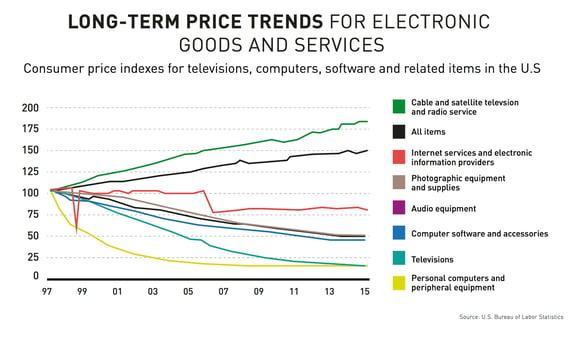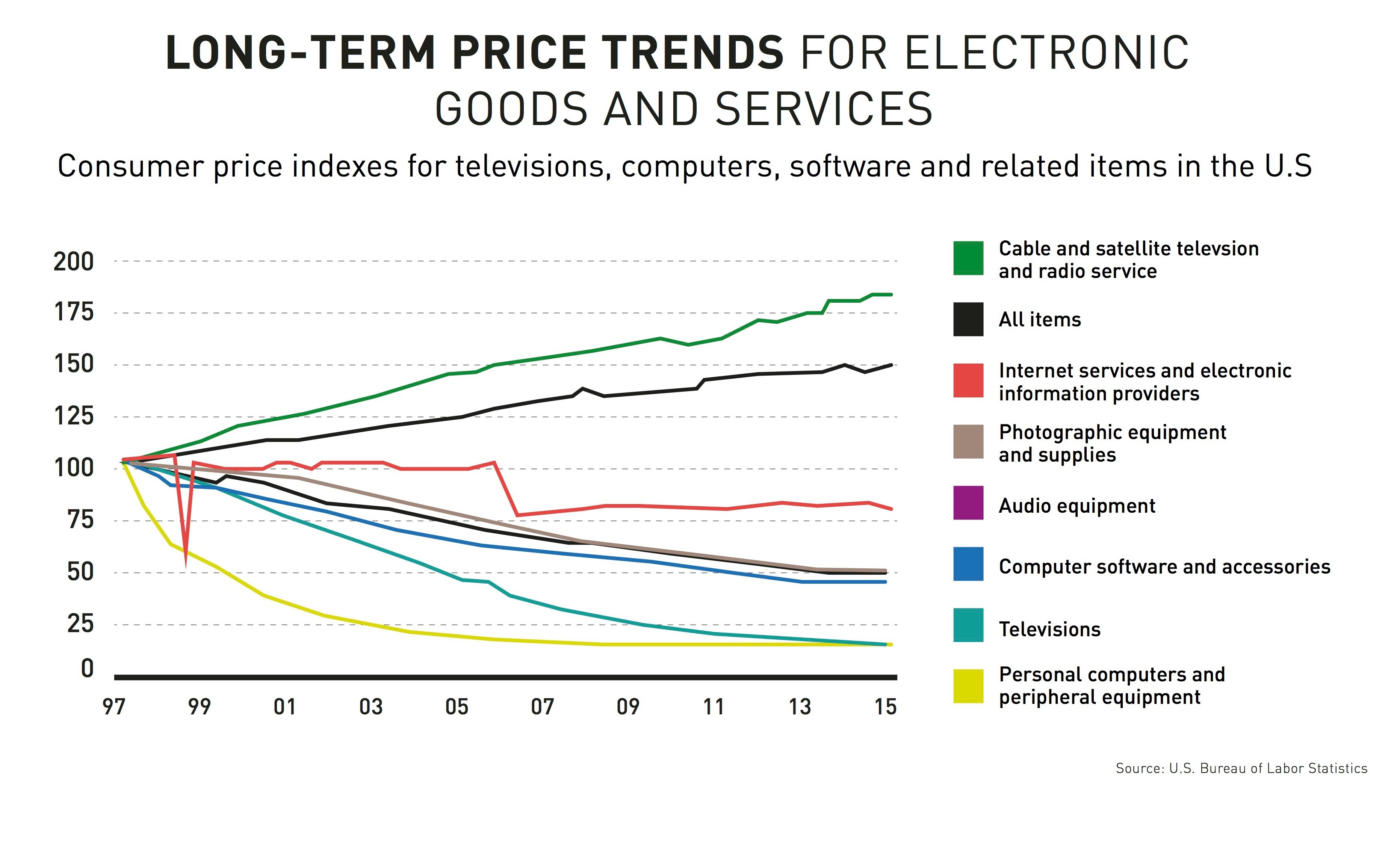Foresights and ideas that expand minds and inspire a change of heart.

During the last two decades we have seen a remarkable growth of new technology and innovations, and as a result of this fast development many advanced technology products have become accessible and affordable for a big segment of consumers.

This graph visualizes the long term price trends for electronic goods and services in the U.S. Personal computers, televisions, computer software and photographic equipment have all gotten significantly cheaper during the last two decades according to U.S. Bureau of Labour Statistics. The product category that have experienced the biggest price drop is personal computers followed by televisions, computer software and photographic equipment.
One of the key aspects that's driving this trend of declining prices is Moore's Law. So what is Moore's Law? Back in 1965 Gordon Moore, the Co-founder and Chairman Emeritus of Intel Corporation, made a prediction that the number of transistors you can fit on a chip will continue to double every 18 month (in 1975 he revised the prediction to double every two years). According to Intel, this insight became "a golden rule for the electronics industry, and a springboard for innovation." Moore helped Intel drive the production of fast, low-cost and small transistors that you can find in many of today's modern electronic goods.
iIn an interview by Venturebeat Moore said; "We have just seen the beginning of what computers will do for us. The evolution of machine intelligence. It is happening in incremental steps. I never thought I would see an autonomous vehicle driving on our highways.” We are indeed living in fast-changing times. The technological advances within artificial intelligence and machine-to-machine intelligence are already today reshaping and disrupting entire industries. According to research by Intel, the number of IoT devices are predicted to grow from 15 billion in 2015 to 200 billion in 2020.
How should I as a marketer, entrepeneur or CEO deal with this change you might ask? A good first step is to make sure that you are creating a culture of change within your organisation. Otherwise you might end up like businesses such as Blockbuster and Kodak that had deep-rooted attitudes that didn't support business agility and creativity.

Header Text
Lorem ipsum dolor sit amet, consectetur adipiscing elit, sed do eiusmod tempor incididunt ut labore et dolore magna aliqua. Ut enim ad minim veniam, quis nostrud exercitation ullamco laboris nisi ut aliquip ex ea commodo consequat. Duis aute irure dolor in reprehenderit in voluptate velit esse cillum dolore eu fugiat nulla pariatur.
Lorem ipsum dolor sit amet, consectetur adipiscing elit, sed do eiusmod tempor incididunt ut labore et dolore magna aliqua. Ut enim ad minim veniam, quis nostrud exercitation ullamco laboris nisi ut aliquip ex ea commodo consequat. Duis aute irure dolor in reprehenderit in voluptate velit esse cillum dolore eu fugiat nulla pariatur.
Lorem ipsum dolor sit amet, consectetur adipiscing elit, sed do eiusmod tempor incididunt ut labore et dolore magna aliqua. Ut enim ad minim veniam, quis nostrud exercitation ullamco laboris nisi ut aliquip ex ea commodo consequat. Duis aute irure dolor in reprehenderit in voluptate velit esse cillum dolore eu fugiat nulla pariatur.

Header Text
Lorem ipsum dolor sit amet, consectetur adipiscing elit, sed do eiusmod tempor incididunt ut labore et dolore magna aliqua. Ut enim ad minim veniam, quis nostrud exercitation ullamco laboris nisi ut aliquip ex ea commodo consequat. Duis aute irure dolor in reprehenderit in voluptate velit esse cillum dolore eu fugiat nulla pariatur.
Lorem ipsum dolor sit amet, consectetur adipiscing elit, sed do eiusmod tempor incididunt ut labore et dolore magna aliqua. Ut enim ad minim veniam, quis nostrud exercitation ullamco laboris nisi ut aliquip ex ea commodo consequat. Duis aute irure dolor in reprehenderit in voluptate velit esse cillum dolore eu fugiat nulla pariatur.
Lorem ipsum dolor sit amet, consectetur adipiscing elit, sed do eiusmod tempor incididunt ut labore et dolore magna aliqua. Ut enim ad minim veniam, quis nostrud exercitation ullamco laboris nisi ut aliquip ex ea commodo consequat. Duis aute irure dolor in reprehenderit in voluptate velit esse cillum dolore eu fugiat nulla pariatur.

Header Text
Lorem ipsum dolor sit amet, consectetur adipiscing elit, sed do eiusmod tempor incididunt ut labore et dolore magna aliqua. Ut enim ad minim veniam, quis nostrud exercitation ullamco laboris nisi ut aliquip ex ea commodo consequat. Duis aute irure dolor in reprehenderit in voluptate velit esse cillum dolore eu fugiat nulla pariatur.
Lorem ipsum dolor sit amet, consectetur adipiscing elit, sed do eiusmod tempor incididunt ut labore et dolore magna aliqua. Ut enim ad minim veniam, quis nostrud exercitation ullamco laboris nisi ut aliquip ex ea commodo consequat. Duis aute irure dolor in reprehenderit in voluptate velit esse cillum dolore eu fugiat nulla pariatur.
Lorem ipsum dolor sit amet, consectetur adipiscing elit, sed do eiusmod tempor incididunt ut labore et dolore magna aliqua. Ut enim ad minim veniam, quis nostrud exercitation ullamco laboris nisi ut aliquip ex ea commodo consequat. Duis aute irure dolor in reprehenderit in voluptate velit esse cillum dolore eu fugiat nulla pariatur.
& STAY UP TO DATE WITH FORESIGHTS AND TREND REPORTS!
WE WILL EQUIP YOU WITH THE VIDEOS AND MATERIALS YOU NEED TO SUCCESSFULLY PITCH ASN.
0 Comment